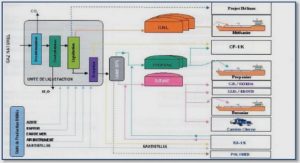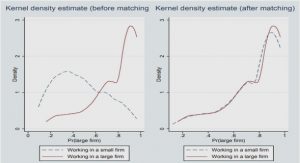Get Complete Project Material File(s) Now! »
Chapter 3: Kinetics and inhibition studies of Isocitrate lyase 1 (ICL1)1
Introduction
Assays for ICL
Several assays were developed to study the kinetics and inhibition of ICLs. The most common assays are based on ultraviolet/visible (UV/vis) spectrophotometry, which rely on the quantification of glyoxylate, one of the products of the enzymatic reaction catalysed by ICL. However, as glyoxylate cannot absorb UV or visible light, it needs to be chemically or enzymatically modified.1
The chemical-coupled method was developed in 1959 by Dixon et al.2 In this method, glyoxylate is chemically modified by phenylhydrazine to form a hydrazone that absorbs UV light at 390 nm. Thus, the conversion of isocitrate to succinate and glyoxylate by ICL is correlated with the amount of hydrazone that is formed (and hence UV/vis absorption). However, the disadvantages of using this method are three-fold. Firstly, this is an indirect measurement of the product glyoxylate. The accuracy of the experiment is dependent on the chemical coupling step. For instance, the rate of glyoxylate-phenylhydrazone complex formation is pH dependent. In particular, the rate slows significantly above pH 7, which may impact on the accuracy of the enzyme kinetic measurement. Secondly, phenylhydrazine is unstable at pH 7 and above. This leads to a slow increase in the UV absorption even in the absence of glyoxylate.3 Thirdly, the accuracy of the experiment may be affected by other components of the reaction mixture such as ICL inhibitors that if aromatic, may absorb UV/vis light at similar wavelengths.
1The work that is described in this chapter was conducted in collaboration with Anne Swartjes, who synthesised (2R,3S)-2-methylisocitrate.
Part of the work from this chapter was published as described in:
An alternative to the chemical coupled method to determine ICL kinetics is to use the enzyme lactate dehydrogenase (LDH).4 LDH catalyses the reduction of glyoxylate to form glycolate. This reaction is coupled with the oxidation of NADH, which is used as a cofactor of LDH, to NAD+. The decrease of NADH can be measured by the addition of the tetrazolium (MTS) dye. When NADH is oxidised, MTS is reduced to soluble formazan, which absorbs UV at 490 nm. There are several limitations with this method. Firstly, it is indirect and is reliant on both the activity of LDH as well as the reduction of MTS to form formazan. Secondly, autoxidation of NADH to NAD+ may lead to inaccurate results over time. Thirdly, this method is not suitable to measure methylisocitrate lyase activity because LDH cannot accept pyruvate as a substrate.5 In addition to kinetic assays, binding assays have also been developed.6 The first assay was based on native non-denaturing mass spectroscopy, which can be applied to study covalent ligand binding (and in theory, non-covalent binding, provided the protein-ligand interaction is strong enough to survive the electrospray ionisation process). The second method was based on intrinsic protein fluorescence. In ICL1, Tyr89 and Trp93 are found in close proximity to the active site. Therefore, upon ligand binding, the intrinsic fluorescence ( ex = 290 nm and em = 320 nm) of the protein may change as a result of changes in environment and/or conformation.
1H nuclear magnetic resonance spectroscopy for kinetics and inhibition studies
The application of NMR spectroscopy to the study of biological systems started in the early 1950s.7 The first publication reporting the use of NMR spectroscopy to study proteins was disclosed in 1968. The authors applied 1H NMR to monitor the hydrolysis of acetylcholine by horse cholinesterase.8, 9 Since then, NMR spectroscopy has become one of the most important biophysical techniques in enzymology.10 For example, NMR spectroscopy is now commonly applied in applications that include structure determination of proteins and enzymes, in situ characterisation of enzyme reactions and products, the studies of protein dynamics and the measurement of protein-ligand interactions.11
The use of NMR spectroscopy to study enzyme kinetics has several advantages. Firstly, all reactants and products (as long as they contain non-exchangeable hydrogens) can be monitored in the same spectrum, provided there is no overlap of signals. Secondly, the amount of substrate consumption and product formation can be accurately quantified by simply following changes in the peak area of the resonances associated with the substrate and/or reaction product(s). Thus, this method does not rely on the accuracy of chemical or enzymatic coupling reactions.
Thermal shift assay for high-throughput screening of protein-ligand interactions
The thermal shift assay was developed in the early 2000s by Pantoliano et al. as a high-throughput technique to screen for protein-ligand binding.12 This method is based on the phenomenon that ligand binding may stabilise13-15 or destabilise16 the protein to thermal denaturation. Thus, ligand binding may be reflected by changes in the protein melting temperature (Tm).
Protein Tm may be measured by the use of a fluorescent dye. When the protein unfolds (for example, due to thermal denaturation), it exposes its hydrophobic core. By using a fluorescent dye that binds hydrophobic amino acids and is sensitive to changes in hydrophobic environment,17 the protein Tm can be measured by following changes in the fluorescence that is emitted due to binding of the dye to the open hydrophobic core of the protein. The assay is simple. It can be applied in an automated fashion using multi-well plate format, thus it is widely applied as a high-throughput method to screen for new protein ligands.12, 18, 19
Objective
The objective of the work described in this chapter is to develop a NMR-based method for the studies of ICL kinetics and inhibition using ICL1 as a model system. In addition to 1H NMR spectroscopy, a thermal shift assay was also to be investigated for screening of ICL inhibitors.
ICL1 kinetics by 1H NMR
Isocitrate lyase activity by 1H NMR
1H NMR was first applied to monitor the ICL1-catalysed conversion of isocitrate to succinate and glyoxylate. DL-Isocitrate, which is commercially available, was used as the substrate. MgCl2 was added to the reaction mixture as Mg2+ was previously shown to be important for ICL1 activity.4 1H spectra were recorded at ~1.3 minute intervals. The experiments were conducted in 90% H2O and 10% D2O (Figure 3.1a). The large water peak was suppressed using the excitation sculpting method so that the resonances of the substrate and product could be visualised and quantified accurately.20 Upon addition of the enzyme, the peaks that corresponded to isocitrate dropped in intensity, which was accompanied by the appearance of a new singlet peak at 2.3 ppm, corresponding to succinate (Figure 3.1b). Glyoxylate cannot be observed because it contains only exchangable hydrogen atoms. Integration of the isocitrate and succinate peaks showed that the reaction appeared to slow down when ~50% of the isocitrate was consumed (Figure 3.1c). As the isocitrate was a racemic mixture, this result infers that ICL1 has a preference for one enantiomer, which is in agreement with a previous study that showed D-isocitrate is the preferred substrate of the enzyme.21
Figure 3.1: (a) Isocitrate lyase catalyses the conversion of isocitrate to glyoxylate and succinate; (b) 1H NMR spectroscopy to monitor ICL1-catalysed turnover of isocitrate into succinate (c) Corresponding plot of the isocitrate turnover data. The curve was added to aid visualisation. The sample contained 190 nM ICL1, 1 mM DL-isocitrate, 5 mM MgCl2 and 50 mM Tris/Tris-D11 (pH 7.5) in 90% H2O and 10% D2O. The hashtag (#) indicates Tris/Tris-D11 peak. The errors shown are the standard deviation from three independent measurements (each sample prepared separately for the measurement).
Role of Mg (II) in the activity of ICL1
Divalent metals play important role in the activity of ICL1. Previous studies showed that Mg2+ (and to a lesser extent, Mn2+) are required for optimal ICL1 activity.4, 22 In order to confirm the concentration of divalent magnesium that is required for optimal activity of the enzyme, the reaction was run using different concentrations of MgCl2. Under the tested reaction conditions, it was found that 500–5000 μM of MgCl2 was required for the optimal activity, and this concentration was therefore used in all subsequent kinetic and inhibition assays (Figure 3.2). The enzyme showed negligible activity without Mg2+. Mg2+ is absolutely required for the reaction because the substrate was proposed to bind the active site of ICL via chelation of a magnesium ion.22, 23 However, any role of Mn2+ cannot be measured by 1H NMR spectroscopy. Mn2+ is paramagnetic, which enhances the longitudinal and transverse relaxation rates of NMR resonances. Thus, the isocitrate and succinate signals will be severely broadened and hence accurate measurements cannot be performed.
Kinetic parameters for ICL1 with DL-isocitrate by 1H NMR
Next, the kinetic parameters of ICL1 were measured. This was conducted using a fixed concentration of ICL1 (190 nM) and Mg2+ (5 mM), and varying concentration of DL-isocitrate. The initial rate was calculated using the turnover of isocitrate to succinate and glyoxylate over four minutes. The kinetic parameters were calculated using Hanes-Woolf plot, which involved linearisation of the Michaelis-Menten equation for the analysis of kinetic data (Equation 3.1).24
Kinetic parameters of ICL1 with DL-isocitrate as substrate. Measurements were made using samples containing 190 nM ICL1, varying concentrations of DL-isocitrate, 5 mM MgCl2 and 50 mM Tris/Tris-D11 (pH 7.5) in 90% H2O and 10% D2O. The errors shown are the standard deviation from three independent measurements (each sample prepared separately for the measurement).
Kinetic parameters of ICL1 with (2R,3S)-2-methylisocitrate by 1H NMR
It was reported that mycobacterial ICL1 may catalyse the conversion of (2R,3S)-2-methylisocitrate to pyruvate and succinate in presence of Mg2+ (Figure 3.4a). In order to test this proposal, (2R,3S)-2-methylisocitrate was synthesised according to the procedure reported by Darley et al (by Anne Swartjes),26 and the reaction was monitored by the 1H NMR assay at ~1.3 minute intervals. Upon addition of the enzyme, the peaks corresponding to (2R,3S)-2-methylisocitrate dropped in intensity, a change which was accompanied by the appearance of two new singlet peaks at 2.3 and 2.26 ppm corresponding to succinate and pyruvate (Figure 3.4b). The keto-enol tautomerism of pyruvate (Figure 3.5) under the reaction condition directly effects the intensity of –CH3 peak of pyruvate,27 so we did not use the –CH3 peak of pyruvate for quantification of enzyme kinetics. The kinetic parameters were calculated using Hanes-Wolf plot. The Michaelis constant (KM) was found to be 560 ± 28 μM and the catalytic constant (kcat) was determined to be 0.5 ± 0.1 s-1 (Figure 3.6). These values were not much different to those obtained by Gould et al. using the aforementioned LDH assay, which were 720 μM and 1.25 s-1 respectively (Table 3.2).25
Abstract
Acknowledgements
Abbreviations and acronyms
Chapter 1: Introduction
1.1 Tuberculosis (TB)
1.2 Energy metabolism of M. tuberculosis
1.3 Isocitrate lyase (ICL)
1.4 Structural and mechanistic aspects of ICL
1.5 Inhibition of mycobacterial ICL as potential anti-TB therapy
1.6 Overview of this Thesis
Chapter 2: Recombinant production and purification of Mycobacterium tuberculosis isocitrate lyase
2.1 Introduction
2.2 Objectives
2.3 Production and purification of ICL1
2.4 Production and Purification of ICL2
2.5 Production and purification of ICL2a and ICL2b
2.6 Conclusion
Chapter 3: Kinetics and inhibition study of Isocitrate lyase 1 (ICL1)
3.1 Introduction
3.2 Objective
3.3 ICL1 kinetics by 1H NMR
3.4 1H NMR and thermal shift based method for inhibition studies of ICL1
3.5 Conclusion
Chapter 4: Structural and biochemical studies of M. tuberculosis isocitrate lyase 2 (ICL2)
4.1 Introduction
4.2 Objectives
4.3 Crystallography of ICL2
4.4 Structure of ICL2
4.5 Kinetics studies of ICL2
4.6 Thermal shift assay of ICL2 in the presence of acetyl-CoA
4.7 Crystallisation of ICL2 in the presence of acetyl-CoA
4.8 Active site of ICL2
4.9 Conclusion
Chapter 5: Itaconic acid as a green and sustainable substrate for pharmaceuticals
5.1 Introduction
5.2 Objective
5.3 Result and Discussion
5.4 Conclusion
Chapter 6: Materials and methods
6.1 Protein production and purification
6.2 NMR Methods
6.3 Thermal shift assay
6.4 X-ray crystallography
6.5 Synthesis of N-heterocycles
References
GET THE COMPLETE PROJECT
Biochemical and structural studies of Mycobacterium tuberculosis isocitrate lyase Ram Prasad






